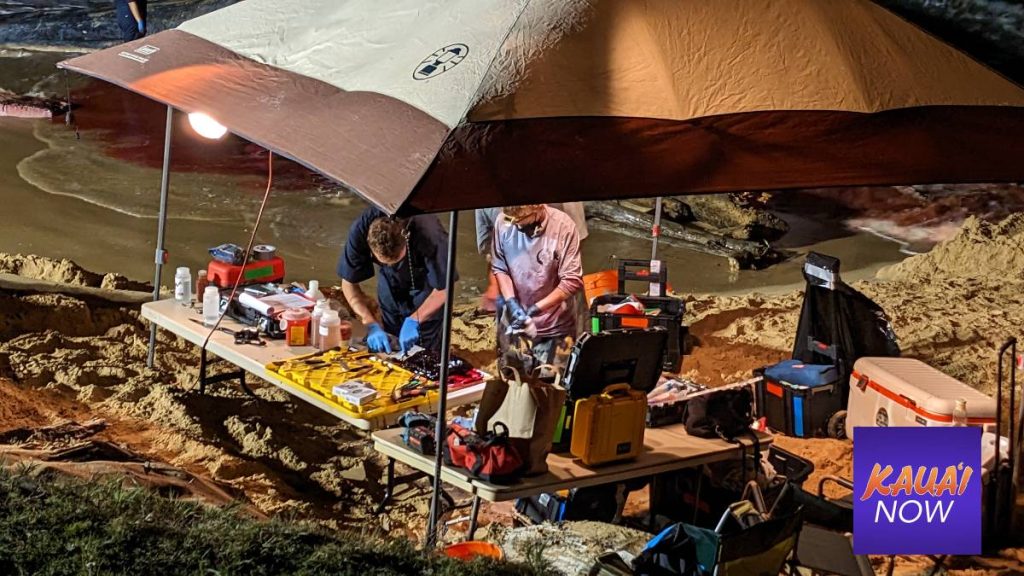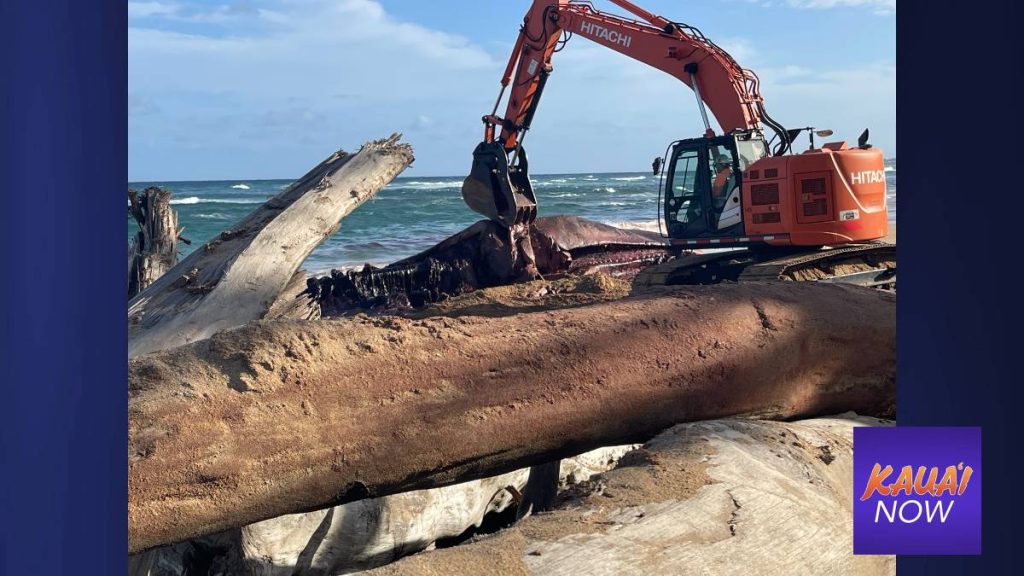Native Hawaiian group concerned, angry over response to dead beached whale on Kaua‘i

A Native Hawaiian group is “concerned and angry” with a federal-led response to a dead sperm whale that recently washed up in Wailuā on the East Side of Kaua‘i.
Several excavators were needed during the 48-hour effort to dismember, remove and bury the 60-ton, 56-foot-long palaoa (Hawaiian for “sperm whale”) in a secret location.
“What transpired on scene was sloppy and continued cycles of trauma, violence and disregard for the rights of indigenous peoples who are guaranteed free, prior and informed consent.”
That was a statement made on Monday by Kia‘i Kanaloa, a multi-island network of Hawaiian cultural and religious practitioners who respond to reports of distressed and deceased marine mammals.
Kia‘i means “guardian” while “kanaloa” means “a major god.” Kia‘i Kanaloa uses “kanaloa” in reference to the marine mammals it cares for.
The National Oceanic and Atmospheric Administration National Marine Fisheries Service was among the agencies behind the removal of the whale’s remains on Jan. 28 and 29 from Lydgate Beach Park in Wailuā. The operation also included personnel from the County of Kaua‘i, the Hawai’i Department of Land and Natural Resources and the University of Hawaiʻi Health and Stranding Lab.
Kia‘i Kanaloa slammed the work of Health and Stranding Lab scientists contracted by NOAA Fisheries to collect samples from the sperm whale before its land burial.
“The greed for science superseded common sense, ethics, ordinances and common courtesy for the Kauaʻi community,” said the group, which advocates for ceremonial sea burial of kanaloa. “While some agencies saw this kanaloa as a ‘specimen,’ we understand that this kanaloa is our ancestor and as such, requires us to engage in a specific manner.”
The Kia‘i Kanaloa members’ statement also described the activity at Lydgate Beach Park as “acts of desecration.”
Later analysis conducted by the Health and Stranding Lab scientists indicated consumption of marine debris was at least a contributing factor in the sperm whale’s death. Its stomach contents included fishing nets, fishing line and plastic bags.
NOAA Fisheries is responsible for the protection and conservation of sperm whales under the Marine Mammal Protection Act and the Endangered Species Act.
“We take our responsibilities very seriously, and as standard practice we work hard to accommodate Hawaiian cultural and religious practices during stranding response to the maximum extent practicable and allowable under the MMPA, ESA and other legal authorities,” said the NOAA Fisheries Pacific Islands Regional Office in Honolulu.
NOAA Fisheries consulted with other agencies and local Hawaiian cultural practitioners before deciding its final course of action, according to the Pacific Islands Regional Office.
“Ultimately, federal and county officials prioritized human health and safety, including zoonotic (animal to human) disease and shark risk in considering a final resting place for the whale,” the Regional Office said. “We recognize that cetacean strandings are emotional and challenging events for all involved. Our hope is that we can continue to work together with Native Hawaiian practitioners and other community members in an open and productive manner as we move forward.”

Billy Kinney, a Kaua‘i resident and member of Kia‘i Kanakoa’s 10-person working group, pointed to the “Kumulipo” – a fundamental Hawaiian creation chant – when discussing the importance of sperm whales.
The “Kumulipo” describes the birth of the whale “living in the sea, guarded by the aoa [sandalwood] living on land” before the eventual arrival of humanity.
“They connect us to divinity as being one of the first manifestations of our natural world,” Kinney said, referring to sperm whales as “akua.”
“Akua” means “god” in English. But according to Kinney, this Western translation is not quite right.
“They [the whales] are a natural phenomenon,” he explained. “But … they connect us to pō, which is the dark, infinite realm of potential, where everything comes from.”
Sperm whales routinely dive up to 2,000 feet below the surface of the ocean in search of prey species like squid, sharks, skates and fish. They can even dive more than 10,000 feet down for over 60 minutes.
These deep sea dives are metaphoric versions of the whales’ cosmic journeys to pō.
“When they dive to those depths … they retrieve ancestral memories, ancestral knowledge, ancestral consciousness,” Kinney said. “Then they come to the surface and when they break the surface of the ocean, they’re sharing that ancestral memory, that ancestral knowledge and that ancestral consciousness with the human world.”
Up to eight Hawaiian cultural practitioners were present for the entire 48-hour removal of the sperm whale from Lydgate Beach Park in Wailuā, according to Kinney. Up to 30 practitioners were present for shorter periods of time, in addition to an unknown number of sightseers.
Roxane Keliʻikipikāneokolohaka, a Hilo-based founder of Kiaʻi Kanaloa, said her organization is not opposed to necropsies performed on marine mammals “when done respectfully.” She would have preferred to have seen Kaua‘i’s sperm whale weighted down for burial at sea.
“One [whale] of this size is a big, big undertaking, but we have been successful in burial at sea,” Keliʻikipikāneokolohaka said. “Even modern contemporary Western science will talk about how whale falls are critical to the ecosystem.”
“Whale falls” occur when a whale dies and sinks to the bottom of the ocean. Its carcass soon becomes a rich source of food and habitat for smaller creatures. (For footage of a whale fall in the Monterey Bay National Marine Sanctuary off the coast of California, click here.)

“I don’t even know if [NOAA Fisheries] has looked into being able to do a necropsy at sea, on some sort of boat or anything like that,” Keliʻikipikāneokolohaka said.
Keliʻikipikāneokolohaka used the word “maha‘oi” when describing the sperm whale’s dismemberment and burial on Kaua‘i.
“Mahaʻoi is when you’re being intrusive for personal gain,” she said. “This kanaloa was massive … having it land on the beach makes it that much more of a difficulty for us [Hawaiian cultural practitioners] to then properly see to the disposition of the kanaloa. [But] allowing it to land on shore makes it very convenient and easy for the necropsy to happen.”
Members of Kia‘i Kanakoa met with Kaua‘i Mayor Derek Kawakami on Tuesday, Jan. 31, days after the whale’s burial. The Native Hawaiian group expressed satisfaction with the outcome of the meeting.
“While the county’s highest priority in any beached whale incident is health and safety, we also understand and appreciate the cultural sensitivity,” Kawakami’s Chief of Staff Sarah Blane said. “As much as possible, we want to accommodate the time and space for cultural and religious practices. Our meeting with Kia’i Kanaloa provided us a better understanding of the various perspectives and priorities to help us to do so.”














